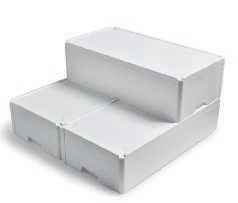
2 minute read
INNOVATION CHALLENGE #9
Count what counts
How can we ensure uniform, comprehensive methods of comparison, so that the best sustainable solution overall is chosen?
How can we ensure uniform, comprehensive methods of comparison, so that the best sustainable solution overall is chosen?
Certification and labeling schemes in construction are rapidly gaining ground. And are an important way to make sure that sustainable solutions are chosen on a uniform and qualified basis. However, producers still find that it can be difficult for customers to fully understand the sustainable footprint of plastic. And therefore, it can be difficult to know which solution is right - both when it comes to choosing plastic versus other materials, or when having to choose between two different types of plastic. It is difficult to compare apples and oranges.
Procurement professionals and consultants who must calculate a material’s climate footprint often use general databases, such as EU data for a given Material type. But there is a big difference between an average value and the value best in class can provide. Companies that invest in improved sustainability must therefore deal with a three-part budget item. First is the actual cost of reducing a resource’s footprint, then comes cost of getting it documented by a third party, and last but not least is what it costs to make certain that the industry knows the specific values of their products.
Another factor is that materials are often compared directly by quantity and not by their overall performance. This does not always give a fair picture.
For example, some materials achieve a higher insulating capacity through more energy-demanding raw materials and processes. Per kg material, this may seem more resource-intensive, but since less of the material is needed, its overall footprint is lower.
Finally, experience shows that there are many labeling and certification schemes, and they differ from country to country. It can be difficult for manufacturers to choose the right type of certification, which in the end also makes it difficult for their customers to choose the right sustainable solution.
In particular, it is difficult to test and document solutions that, in terms of material composition and especially function, are significantly different from known solutions on the market. The test and calculation methods used today are primarily determined based on an industry’s existing solution palette. Innovative companies must therefore spend time and resources influencing and securing industry recognition of new test and calculation methods before the actual testing and documentation of a new product can take place. The extra costs and the longer maturation time for a product are particularly problematic for smaller, start-up companies, and increased requirements for certification thus risk becoming a double-edged sword: On the one hand, higher demands increase the demand for new solutions, on the other, it increases market barriers for innovative companies that work with new approaches to sustainability.
Key issues
• How can it be made easier to spread knowledge about the environmental values of an individual producer’s material so that the most sustainable companies are not dragged down by lower average values for the entire industry.
• How to ensure that the criteria for choosing materials are based on calculations of overall performance and not simply on a direct quantity comparison.
• How can we create peace of mind when using new and more sustainable solutions while keeping the costs of their testing and documenting affordable?
Sustainability – the bigger picture
Example: BEWI boxes for fish transport and hot food are light and durable, reducing CO2 consumption from transport and food waste.

Perfectly imperfect ARCHITECTURE AND HOLISTIC PERSPECTIVE
When plastic is best
Material-driven design
Made for disassembly
ENGINEERING AND MATERIALS DECISION-MAKING AND PRODUCTION AND DEMAND
BUSINESS for
XL markets for mixed recycled plastic
When not everything is ”small combustibles”
Converting production
Count what counts
Plastic Pavilion






